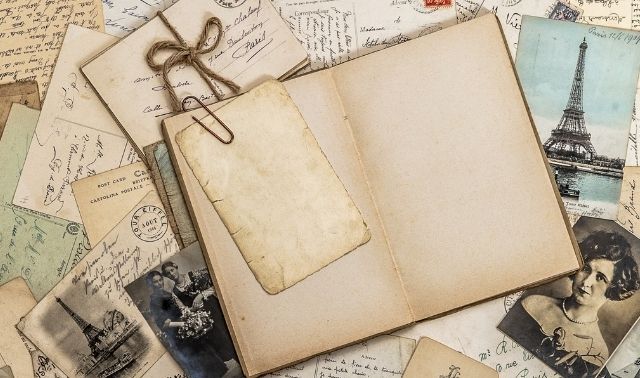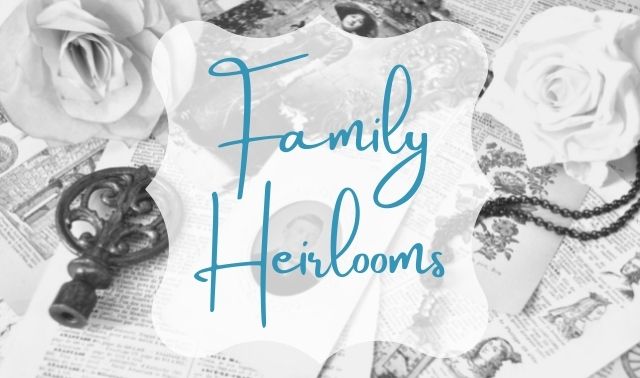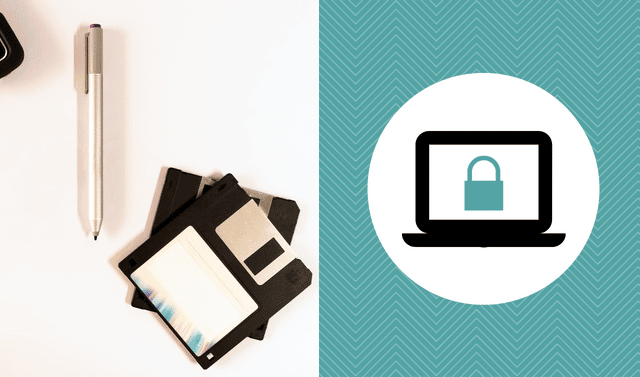Mark Twain did it. So did singer-songwriter Woody Guthrie. Was your ancestor also one of the many Americans who engaged in the popular 19th- and 20th-century pastime of scrapbooking?
If so, you have a treasure. A scrapbook is often a window into the mind of its owner, depicting, for example, a dry wit, a love of nature, or an interest in people or events that you might not discover any other way. In addition to genealogical information, a scrapbook can show you places your ancestor visited, foods she enjoyed and people she met along the way.
Matchbooks, dance cards, paper napkins, candy, gum, food wrappers, bugs, pressed leaves, dried corsages, ribbon, buttons, license plates, pins, military medals—you name it, and you might find it in an old scrapbook. All those bits and pieces that make a scrapbook so wonderful are exactly what also make preserving the book so difficult. Unlike a photo album that calls for the specific care of photographs and paper pages, a scrapbook’s contents may need special individual attention. To make matters more difficult, old scrapbooks were usually constructed from inexpensive materials such as acidic paper and cardboard, which are poor choices for longevity.
Fortunately, the best way to care for your family’s vintage scrapbook is both simple and fairly inexpensive. You can preserve and enjoy your family treasure with this five-step treatment regimen.
1. Examine the Scrapbook’s Materials
Take a good look at your heirloom scrapbook. The covers probably are made of paper-coated embossed cardboard with or without a printed title. Some scrapbook covers are made of carved wood or tooled leather. Others began life as ledger books, notebooks or journals and were recycled into scrapbooks. All of these materials are highly acidic and will discolor and become brittle over time. Wood and leather are particularly damaging to any other materials they might touch due to a condition known as “acid migration.” If you’ve ever seen the darkened shadow left by a newspaper clipping stored inside a book, you’ve seen the results of acid migration.
Whether black, white or cream, the paper typically used in old scrapbook albums is highly acidic. This doesn’t mean that it’ll disintegrate before your eyes, but it does mean that the paper is unstable and will continue to interact with other items on the page.
2. Identify and Mitigate Damage
You can increase your scrapbook’s chance of survival with some common-sense “first-aid” treatment solutions.
Assess damage
Go through your scrapbook page by page, looking for signs of damage. Keep an eye out for holes from silverfish, moths or other pests; discoloration caused by acid migration from adjacent items; food or crumbs; rusting metal paper clips, pins, safety pins and staples; and yellowing newsprint and news clippings.
Remove or acidic materials
Use a soft brush to remove any crumbs, bugs or loose objects. If an item is causing damage to another, remove the offending item but leave a note in its place—written in pencil on acid-free paper—to indicate what’s been removed. For example, you’ll want to store rusting political campaign buttons in a display case where they won’t damage the inaugural ball invitation on the facing page. Otherwise, just leave everything in its original place.
Another option is to place the offending item in an archival polyester sleeve or archival paper envelope. This will maintain the provenance, or original intent and history, of the scrapbook and protect other items from further damage.
Newspaper clippings are among the biggest offenders in scrapbooks due to their acidic nature. To preserve the information in a newspaper or clipping, take time to scan or photocopy the article and print out a copy on acid-free, lignin-free paper.
Add buffers
If your scrapbook’s binding will accommodate additional pages, consider protecting the contents from further damage by interleaving archival paper between the pages. Choose a lightweight archival paper specifically designated as “interleaving paper.” This should be acid-free, lignin-free and buffered. The buffering agent, usually calcium carbonate, helps keep the paper and adjacent materials from becoming more acidic over time.
Loosen the binding
Your scrapbook may be bursting at the seams with little or no room for extra pages. If the book is held together by a cord or post-and-screw binding, you may be able to loosen the binding to allow for the slight bulk of the interleaving papers. If it’s tightly bound, use a limited number of interleaving papers to protect the most valuable items from additional damage.
3. Carefully Take Apart the Book
Scrapbooks that have been well used and frequently handled may show signs of all that affection. What do you do with a scrapbook that has completely fallen apart, or with a book that’s lost its covers or many pages?
Don’t give up, even with scrapbooks that are completely disintegrating. The Northeast Document Conservation Center (NEDCC) recommends disbinding—removing the pages from the covers and binding—and storing the pages flat inside individual folders inside an archival box. Disbinding also makes it easier to handle individual pages (as opposed to a large, awkward book) when photographing or scanning individual pages.
After removing the covers from the scrapbook, use a No. 2 pencil to number each page in the exact order you found it. Place each page in an archival folder with a 1-inch margin on all sides, and place the folders inside a suitably sized archival box. The box shouldn’t be so large that the folders will slide around and cause damage to the pages. If you have the scrapbook covers, include them in the box in the appropriate order, top and bottom.
Professional conservators use a more aggressive treatment for historic scrapbooks and documents: It involves removing all objects from each page, deacidifying the items, and encapsulating the page in archival polyester. It’s a painstaking procedure difficult to recreate at home. Therefore, proper storage is a better option for family historians, says Donia Conn, NEDCC education coordinator.
4. Scan the Entire Book
Before you carefully pack your scrapbook inside an archival box and store it away, take time to make a digital copy of the entire book—and store multiple copies on multiple media in multiple places, advises Conn. It’s the best way to ensure that your family heirloom will survive for the next generation. You can digitize your keepsake two ways:
Using a digital camera or smartphone
Scrapbooks can be large, heavy and awkward to handle, so it’s often easier and safer—as well as kinder to the album—to photograph each page instead of trying to wrestle the book onto a flatbed scanner. All you need to do is carefully turn each page.
At the NEDCC, artifacts are digitized using a digital single-lens reflex camera and a copy stand. At home, Conn recommends placing the highest megapixel camera you have on a tripod. Then follow these steps:
- Place your scrapbook or the individual page on a clean, flat surface with plenty of natural light.
- Secure your camera to the tripod using a sturdy screw-type camera mount. You may be able to reverse the center pole of your tripod so that your camera hangs directly above the scrapbook.
- Use TIFF or RAW file format if available on your camera; otherwise, select the highest-quality JPG.
- Minimize edge distortion by keeping the camera at a distance and using the zoom feature to center the object in the frame.
- Turn off the flash.
- Use a shutter release attachment if you have one. Another option is to use the time-release feature on your camera; this gives you time to set the photo and step away from the camera to get a steady shot.
Using a scanner
Use a scanner only if you have individual pages small enough to fit easily on the glass of your flatbed scanner. Set the scanner software according to the kind of items on the page—documents, photographs or newspapers. If you have a combination of items, opt for photos and check the descreening option for the newspaper items. Always scan in full color.
- Clean the glass scanner bed with a clean dry cloth.
- Set the scanner for documents or photographs depending on what is on the scrapbook page.
- Select 24-bit color, 600 dpi, Target Original Size. Be sure to check the option for Descreening if your page includes newspaper clippings.
- Scan the covers, front and back as TIFF files.
- Use batch file naming to save time.
5. Plan for Long-Term Care
How quickly and how much your scrapbook deteriorates depends on so many different factors that it’s impossible to predict how “long” the book will last. What’s inside the book? Food, candy, gum or other perishables may be more damaging than paper napkins, empty food wrappers and ticket stubs. Dried flowers are frequently included in old scrapbooks and can be susceptible to mold or mildew. Newspaper clippings or souvenirs printed on newsprint paper are among the most damaging—and the most commonly included—in scrapbooks.
If your old scrapbook is badly damaged, or you’re worried about future deterioration, resist the temptation to attempt a do-it-yourself conservation project and “remake” the scrapbook with new archival materials.
Remaking a scrapbook might sound like a smart and practical idea, but there’s really no good way at home to easily soak items off a scrapbook page, says Conn. Some glues and adhesives will refuse to soften, and you could end up with an even bigger problem.
Instead, try a simple approach recommended by the NEDCC: Store your scrapbook in a suitably sized archival box to protect it from damage and handling. Proper archival boxing is a much better option, and it will protect your precious scrapbook from dust, light, and “mechanical damage” due to handling, Conn says.
For maximum protection, scrapbooks should be stored in a box that closely matches the actual dimensions of the filled book. Scrapbooks rarely lie completely flat; the thickest point is usually in the middle or along the outer edge. Measure each dimension of your book— height, width and depth at the thickest point. Add 1 or 2 inches on each side, and purchase an acid-free, lignin-free buffered box from an archival supplier. A box with a drop front will make it easier to access the book. Custom boxes made to your size specifications are also available from Gaylord and MicroClimates Custom Manufacturing.
Store your boxed scrapbook on a flat shelf in the best environment available, and avoid locations such as attics, basements and garages. A good storage spot is a closet located on an interior wall without adjacent plumbing. You want to ensure you keep your family archive in a stable environment; what’s comfortable for you is probably comfortable for your family treasures.
The National Archives and Records Administration recommends the following environmental qualities for optimum preservation: room temperatures between 60 to 70 degrees Fahrenheit; 40 to 50 percent relative humidity; clean air; and good circulation. Avoid excessive moisture that can cause mold or mildew to grow, and keep items away from exposure to light or odors such as smoke or soot. Find more information here.
When you or family members want to turn back the clock and look through old scrapbooks, bring out the boxes and place them on a clean, dry surface. Your dining room or kitchen table is a good spot; just cover the table with a clean cloth or old white sheet to catch any crumbling paper or paste. Ask everyone to wash their hands before handling the book, and keep food and liquids away from the area. Use the box lid to support the cover as you begin to turn the pages, and try to handle the book as little as possible.
Expert Q&A
In the March 2011 issue of Family Tree Magazine, Margaret Burzynski-Bays, curator of manuscripts at the Western Reserve Historical Society in Cleveland, shared scrapbook-preservation advice with at-home archivists:
Responses recorded by Sunny Jane Morton
Q. How can I tell whether an old scrapbook is archivally sound?
A. Assume it’ll be in bad shape if it was made before the 1980s—that includes the cover, binding, pages, glue and ink. For example, albums with pages like black construction paper and those sticky “magnetic” albums are both highly acidic.
Q. Should I try to remove the contents?
A. You don’t necessarily want to take the album apart, because that can do more harm than good. Proper storage is the key. Keep the book in an acid-free box, and store it at a constant temperature and humidity in an interior closet with no pipes in the walls (not in your attic or basement).
Q. Then how can I safeguard what’s inside?
A. If there are photographs or news clippings, slide a piece of acid-free, lignin-free paper in between pages so the items won’t damage what’s on the opposing page when the book is closed. (This is called interleaving.)
Q. What if something is loose or falling out?
A. Don’t use adhesive remover. If you can get your hand or a microspatula underneath something and you feel it will pop off easily, it’s probably worth removing. Put it in an acid-free, lignin-free folder or envelope and slide it back into its original slot between the scrapbook pages.
Q. If I use folders or interleaving sheets, the album gets so thick it won’t close. Suggestions?
A. You may need to unbind it, but that’s not a bad thing, because the binding is probably not archivally sound anyway. Then trim the pages as needed, and slide them into polypropylene sleeves that can be assembled into an acid-free book. Don’t get emotionally attached to the cover and binding itself, but if you must keep it, put it in a separate acid-free box.
Q. Shouldn’t I try to reorganize loose contents chronologically?
A. Try to preserve the original order, because it gives you an idea of what the scrapbook creator was thinking at the time. If you want to rearrange the contents, go ahead and scan the whole thing, and then work with reproductions.
Q. There are hair and teeth samples in the album. What do I do with those?
A. Here at the historical society, we remove them, but there are people who want to keep them. If you remove the samples, keep them in an acid-free envelope or folder. If you leave them in, put tissue between the pages, store the book upright, and don’t squish it (teeth, especially, will make indentations).
Q. How do I preserve captions for an artifact removed from its original position?
A. Scan it so you can match that artifact with its caption. Or copy the text on acid-free paper and slide it in a folder with the item. If it’s a photograph, you can write the caption on the back of the photo with a No. 1 pencil.
Q. What if the album is moldy or mildewed?
A. Don’t attempt to take care of it yourself. Hire a professional conservator, and keep it away from everything else you own. Never store things in Ziplock bags. It’s the worst thing you can do—you’re trapping any moisture in there where mold can thrive.
Q. I’m redoing an album entirely. What suggestions do you have?
A. Get an acid-free archival scrapbook from an archival supply vendor. Don’t glue, cut or laminate original photos or memorabilia (use copies). Photocopy news clippings, which deteriorate quickly, and keep the originals in separate acid-free folders. If you use protective sleeves over the album pages, they need to be open at one end, to allow paper and photos to breathe.
Related Reads
Versions of this article appeared in the March 2011 (by Sunny Jane Morton) and March/April 2013 issue (by Denise May Levenick) of Family Tree Magazine.









